TOYOTA YARIS 2016 Workshop Manual
Manufacturer: TOYOTA, Model Year: 2016, Model line: YARIS, Model: TOYOTA YARIS 2016Pages: 540, PDF Size: 34.12 MB
Page 51 of 540
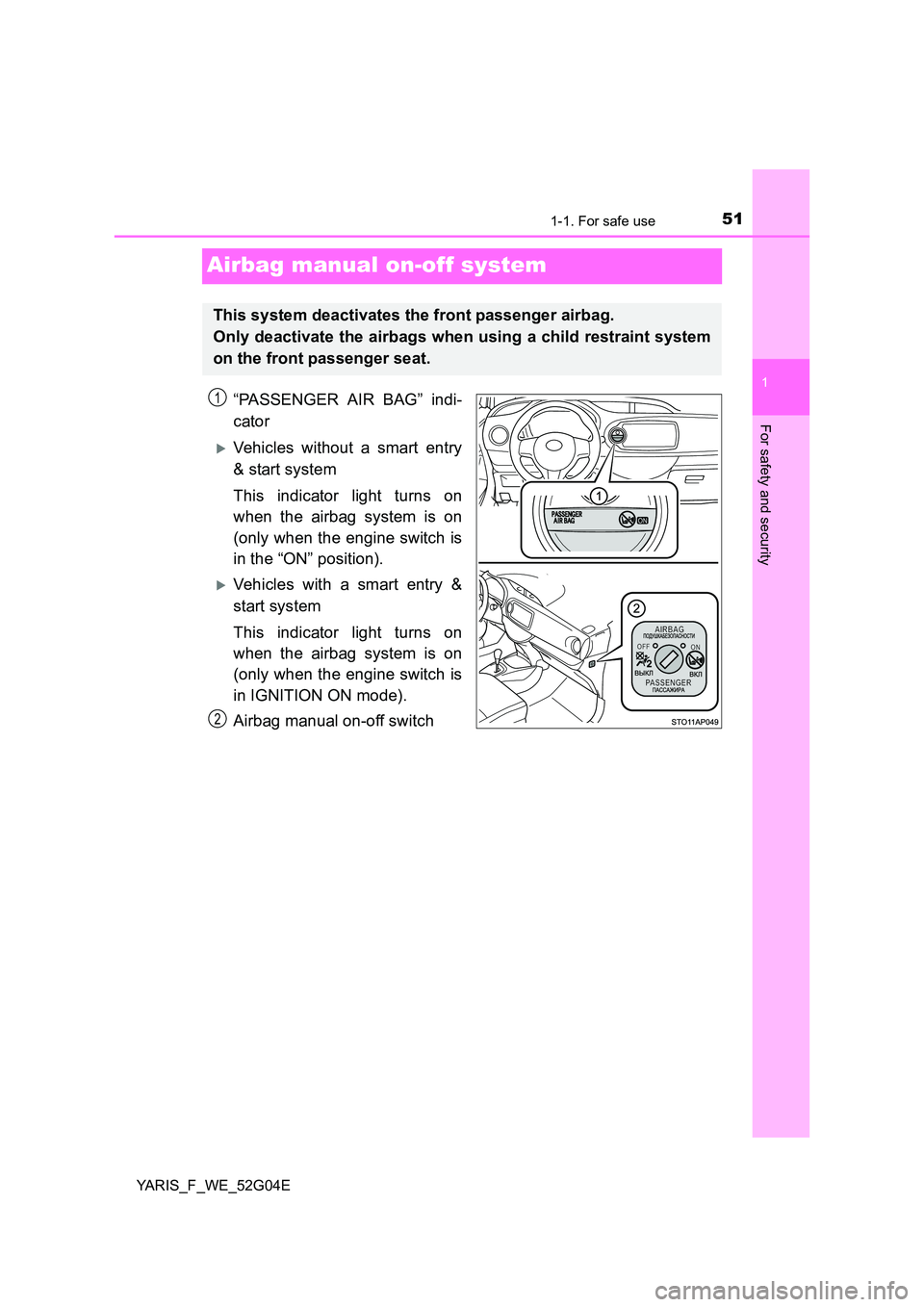
511-1. For safe use
1
For safety and security
YARIS_F_WE_52G04E
Airbag manual on-off system
“PASSENGER AIR BAG” indi-
cator
Vehicles without a smart entry
& start system
This indicator light turns on
when the airbag system is on
(only when the engine switch is
in the “ON” position).
Vehicles with a smart entry &
start system
This indicator light turns on
when the airbag system is on
(only when the engine switch is
in IGNITION ON mode).
Airbag manual on-off switch
This system deactivates the front passenger airbag.
Only deactivate the airbags when using a child restraint system
on the front passenger seat.
1
2
Page 52 of 540
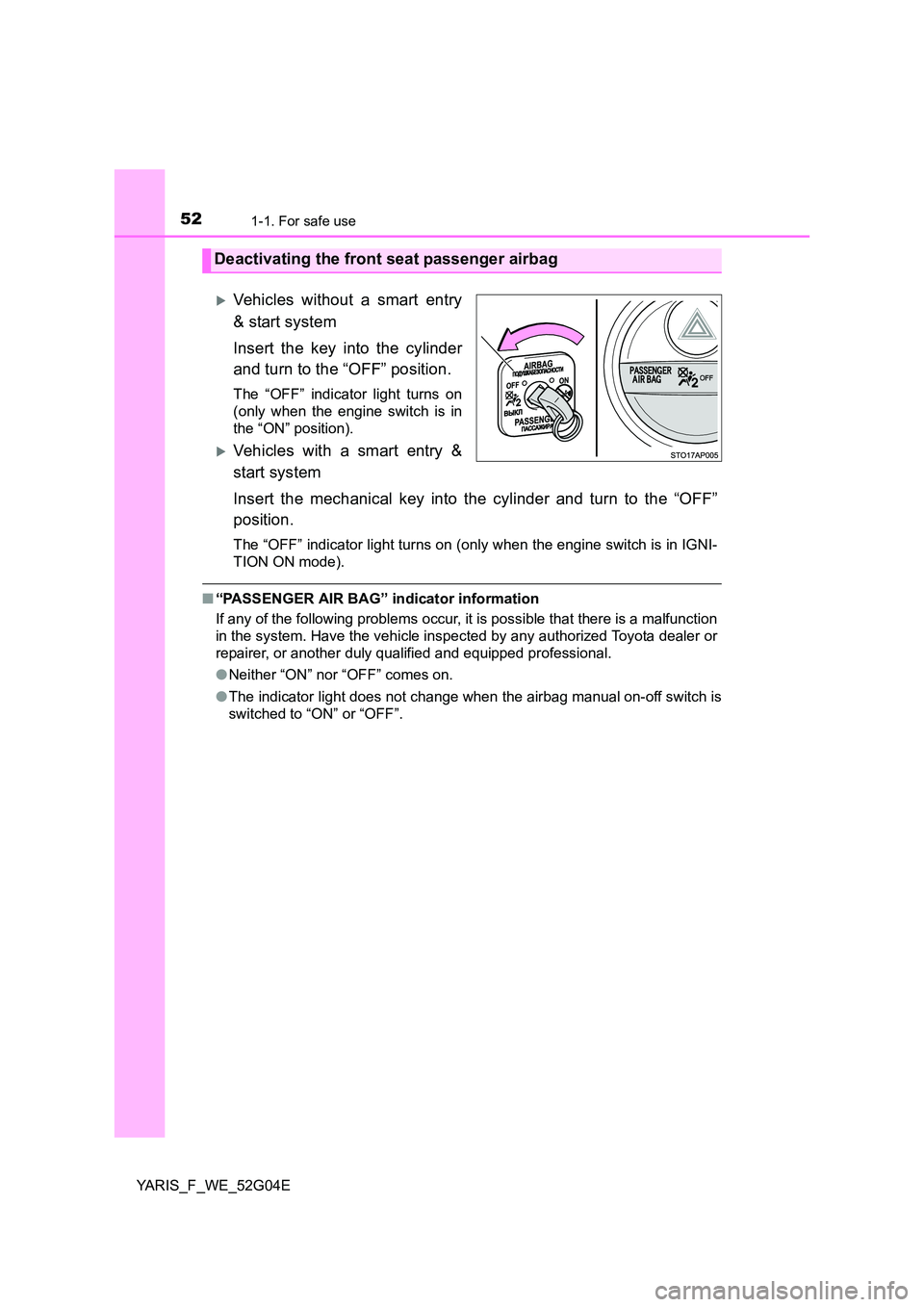
521-1. For safe use
YARIS_F_WE_52G04E
Vehicles without a smart entry
& start system
Insert the key into the cylinder
and turn to the “OFF” position.
The “OFF” indicator light turns on
(only when the engine switch is in
the “ON” position).
Vehicles with a smart entry &
start system
Insert the mechanical key into the cylinder and turn to the “OFF”
position.
The “OFF” indicator light turns on (only when the engine switch is in IGNI-
TION ON mode).
■ “PASSENGER AIR BAG” indicator information
If any of the following problems occur, it is possible that there is a malfunction
in the system. Have the vehicle inspected by any authorized Toyota dealer or
repairer, or another duly qualified and equipped professional.
● Neither “ON” nor “OFF” comes on.
● The indicator light does not change when the airbag manual on-off switch is
switched to “ON” or “OFF”.
Deactivating the front seat passenger airbag
Page 53 of 540
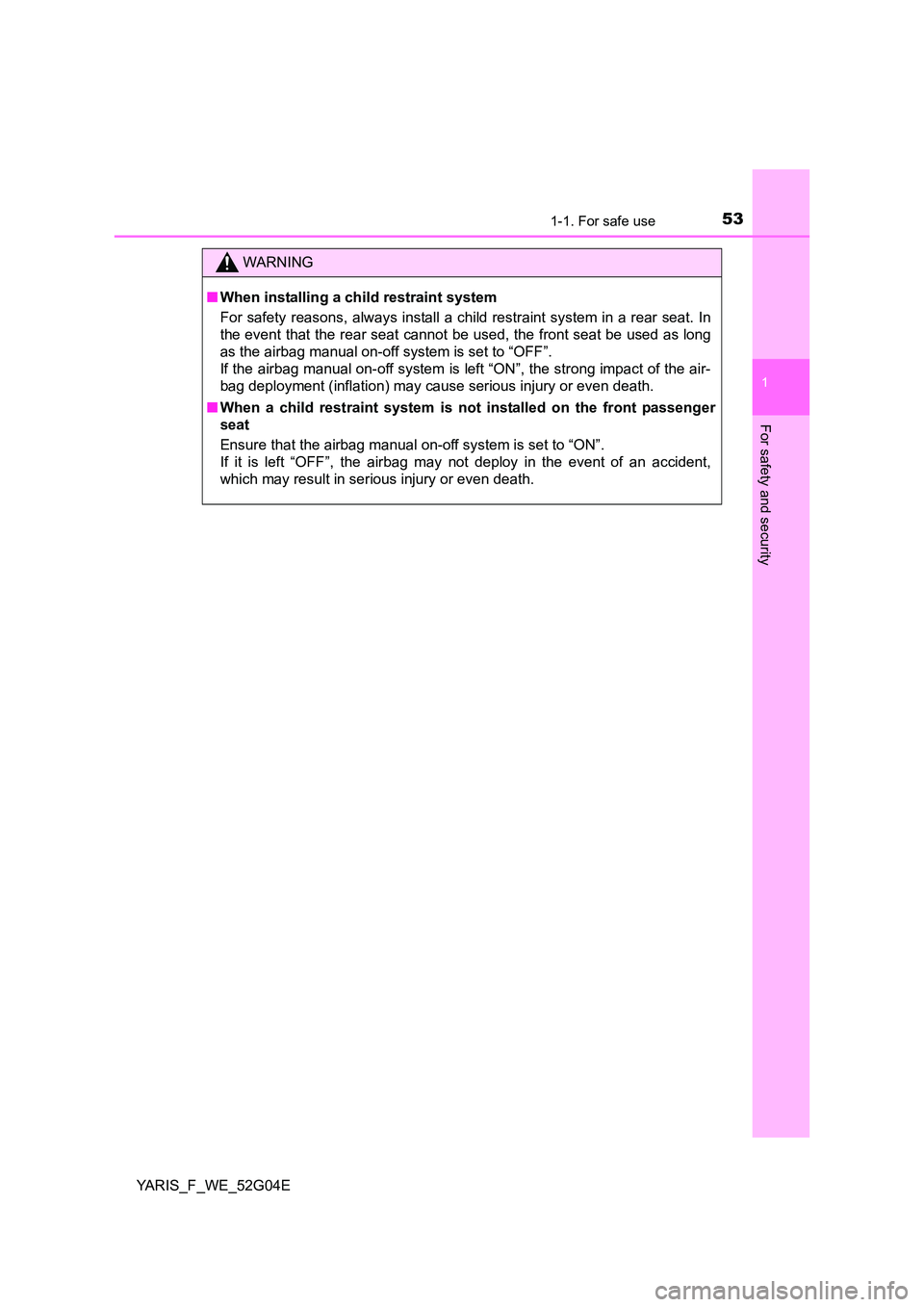
531-1. For safe use
1
For safety and security
YARIS_F_WE_52G04E
WARNING
■When installing a child restraint system
For safety reasons, always install a child restraint system in a rear seat. In
the event that the rear seat cannot be used, the front seat be used as long
as the airbag manual on-off system is set to “OFF”.
If the airbag manual on-off system is left “ON”, the strong impact of the air-
bag deployment (inflation) may cause serious injury or even death.
■ When a child restraint system is not installed on the front passenger
seat
Ensure that the airbag manual on-off system is set to “ON”.
If it is left “OFF”, the airbag may not deploy in the event of an accident,
which may result in serious injury or even death.
Page 54 of 540
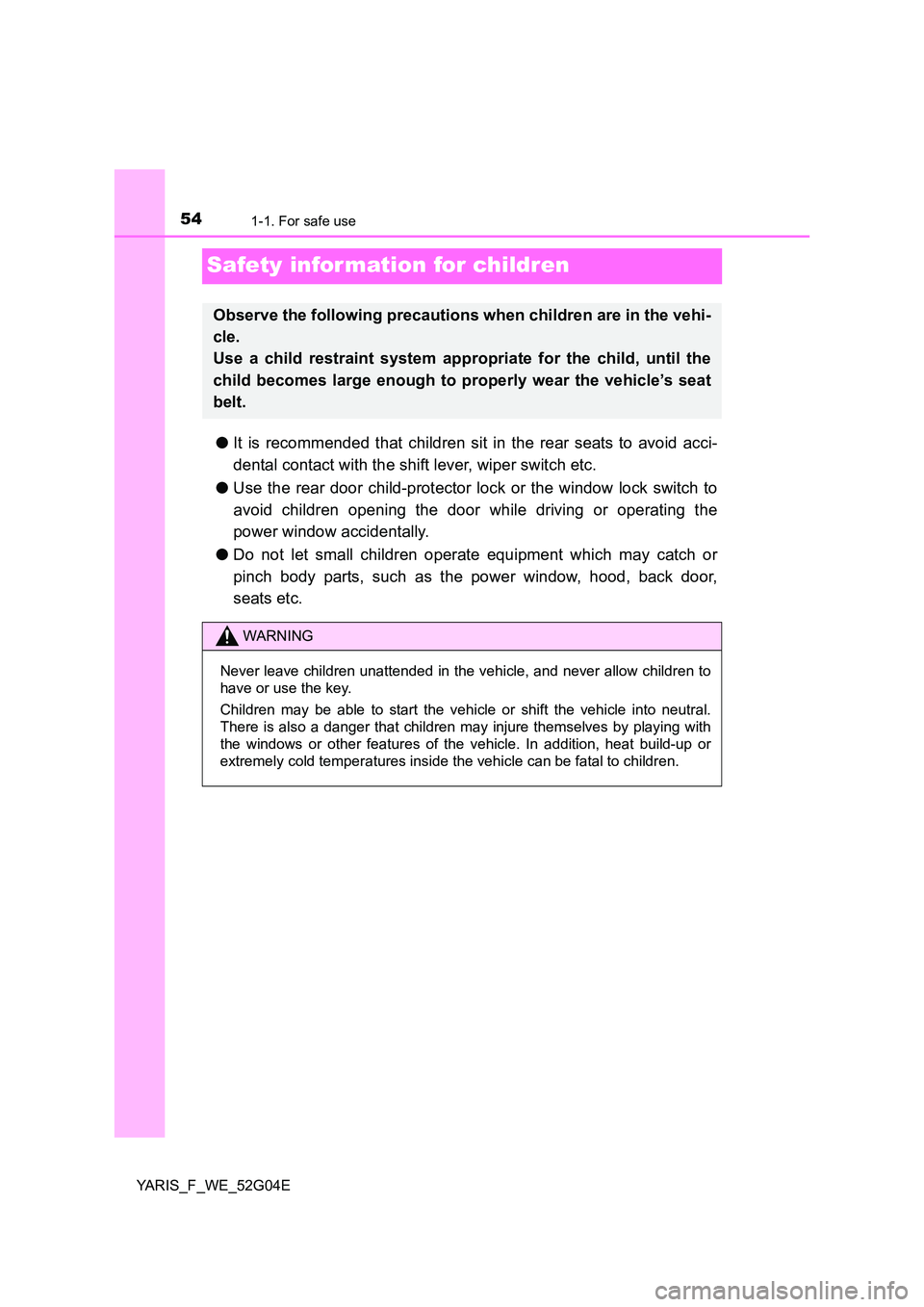
541-1. For safe use
YARIS_F_WE_52G04E
Safety infor mation for children
●It is recommended that children sit in the rear seats to avoid acci-
dental contact with the shift lever, wiper switch etc.
● Use the rear door child-protector lock or the window lock switch to
avoid children opening the door while driving or operating the
power window accidentally.
● Do not let small children operate equipment which may catch or
pinch body parts, such as the power window, hood, back door,
seats etc.
Observe the following precautions when children are in the vehi-
cle.
Use a child restraint system appropriate for the child, until the
child becomes large enough to properly wear the vehicle’s seat
belt.
WARNING
Never leave children unattended in the vehicle, and never allow children to
have or use the key.
Children may be able to start the vehicle or shift the vehicle into neutral.
There is also a danger that children may injure themselves by playing with
the windows or other features of the vehicle. In addition, heat build-up or
extremely cold temperatures inside the vehicle can be fatal to children.
Page 55 of 540
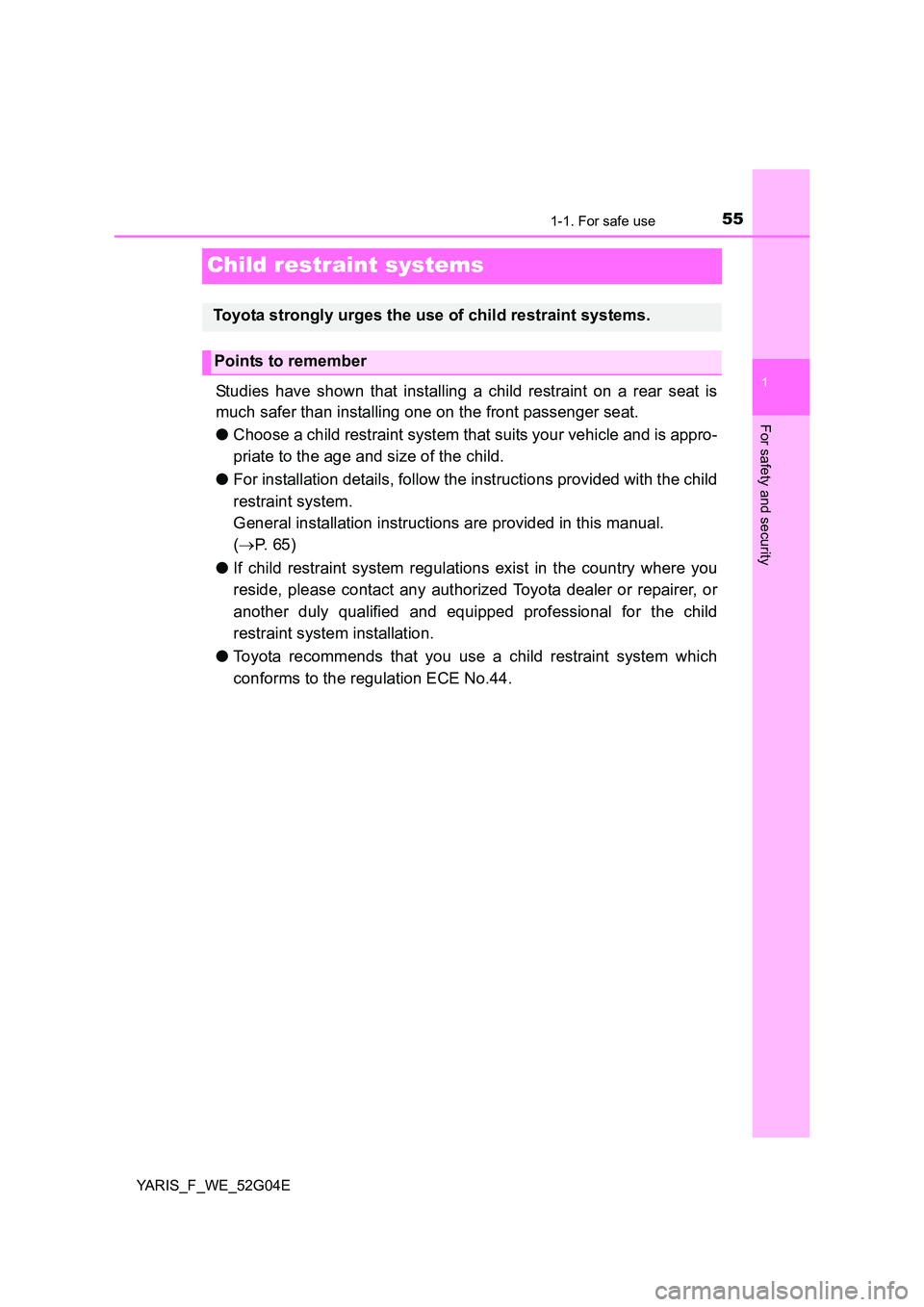
551-1. For safe use
1
For safety and security
YARIS_F_WE_52G04E
Child restraint systems
Studies have shown that installing a child restraint on a rear seat is
much safer than installing one on the front passenger seat.
● Choose a child restraint system that suits your vehicle and is appro-
priate to the age and size of the child.
● For installation details, follow the instructions provided with the child
restraint system.
General installation instructions are provided in this manual.
( P. 6 5 )
● If child restraint system regulations exist in the country where you
reside, please contact any authorized Toyota dealer or repairer, or
another duly qualified and equipped professional for the child
restraint system installation.
● Toyota recommends that you use a child restraint system which
conforms to the regulation ECE No.44.
Toyota strongly urges the use of child restraint systems.
Points to remember
Page 56 of 540
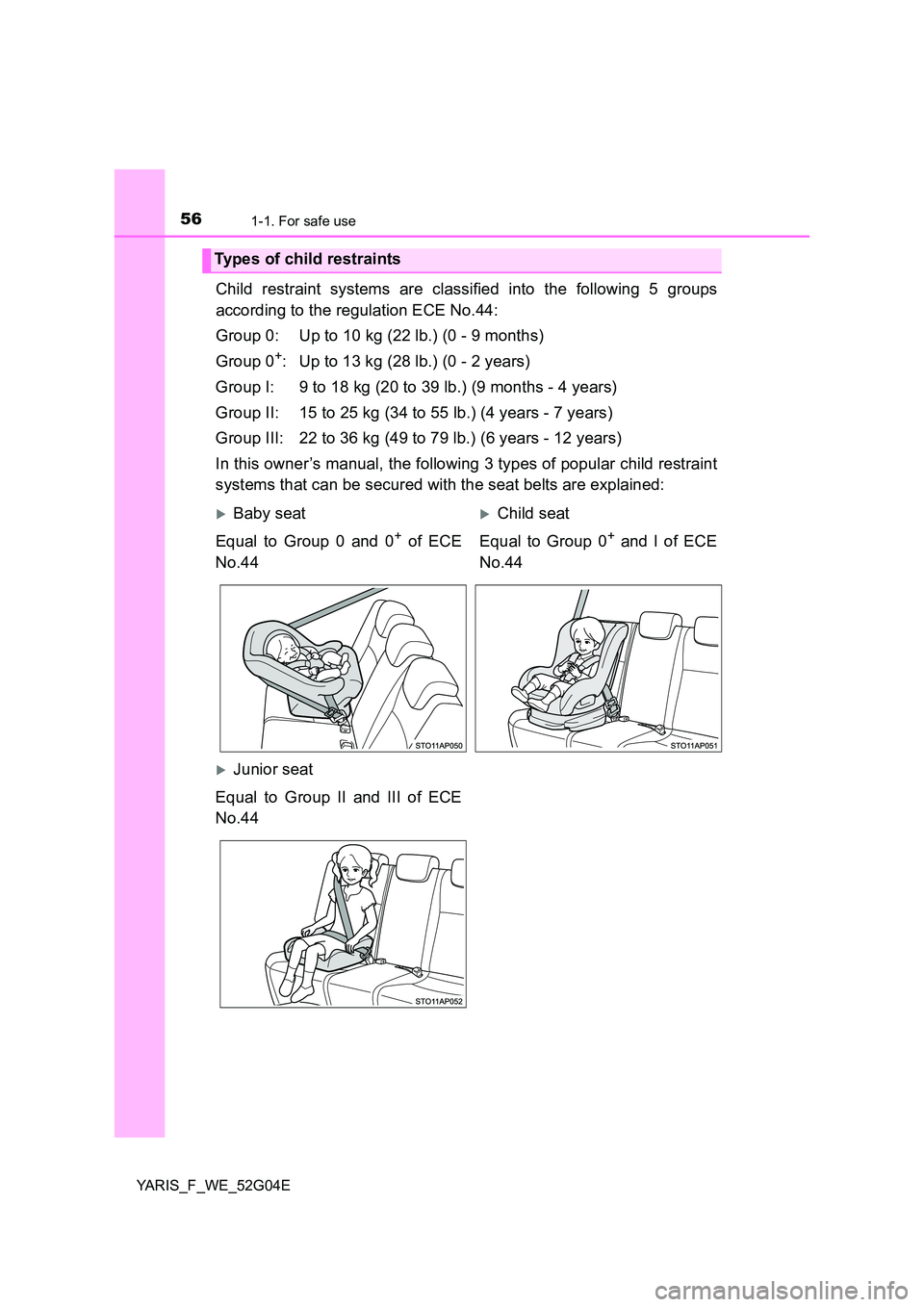
561-1. For safe use
YARIS_F_WE_52G04E
Child restraint systems are classified into the following 5 groups
according to the regulation ECE No.44:
Group 0: Up to 10 kg (22 lb.) (0 - 9 months)
Group 0+: Up to 13 kg (28 lb.) (0 - 2 years)
Group I: 9 to 18 kg (20 to 39 lb.) (9 months - 4 years)
Group II: 15 to 25 kg (34 to 55 lb.) (4 years - 7 years)
Group III: 22 to 36 kg (49 to 79 lb.) (6 years - 12 years)
In this owner’s manual, the following 3 types of popular child restraint
systems that can be secured with the seat belts are explained:
Types of child restraints
Baby seatChild seat
Equal to Group 0 and 0+ of ECE
No.44
Equal to Group 0+ and I of ECE
No.44
Junior seat
Equal to Group II and III of ECE
No.44
Page 57 of 540
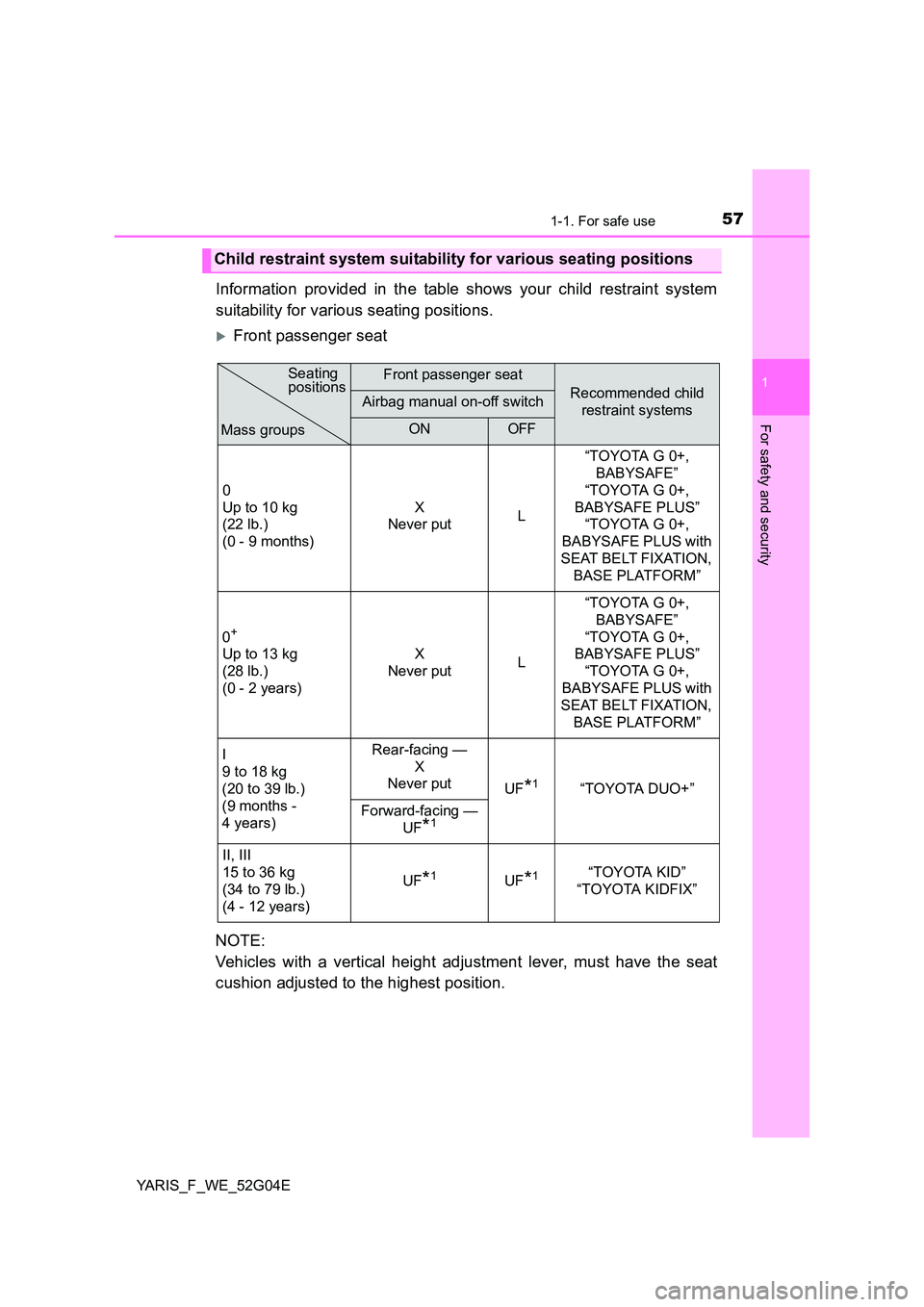
571-1. For safe use
1
For safety and security
YARIS_F_WE_52G04E
Information provided in the table shows your child restraint system
suitability for various seating positions.
Front passenger seat
NOTE:
Vehicles with a vertical height adjustment lever, must have the seat
cushion adjusted to the highest position.
Child restraint system suitability for various seating positions
Front passenger seat
Recommended child
restraint systemsAirbag manual on-off switch
ONOFF
0
Up to 10 kg
(22 lb.)
(0 - 9 months)
X
Never put L
“TOYOTA G 0+,
BABYSAFE”
“TOYOTA G 0+,
BABYSAFE PLUS”
“TOYOTA G 0+,
BABYSAFE PLUS with
SEAT BELT FIXATION,
BASE PLATFORM”
0+
Up to 13 kg
(28 lb.)
(0 - 2 years)
X
Never put L
“TOYOTA G 0+,
BABYSAFE”
“TOYOTA G 0+,
BABYSAFE PLUS”
“TOYOTA G 0+,
BABYSAFE PLUS with
SEAT BELT FIXATION,
BASE PLATFORM”
I
9 to 18 kg
(20 to 39 lb.)
(9 months -
4 years)
Rear-facing —
X
Never put UF*1“TOYOTA DUO+”
Forward-facing —
UF*1
II, III
15 to 36 kg
(34 to 79 lb.)
(4 - 12 years)
UF*1UF*1“TOYOTA KID”
“TOYOTA KIDFIX”
Mass groups
Seating positions
Page 58 of 540
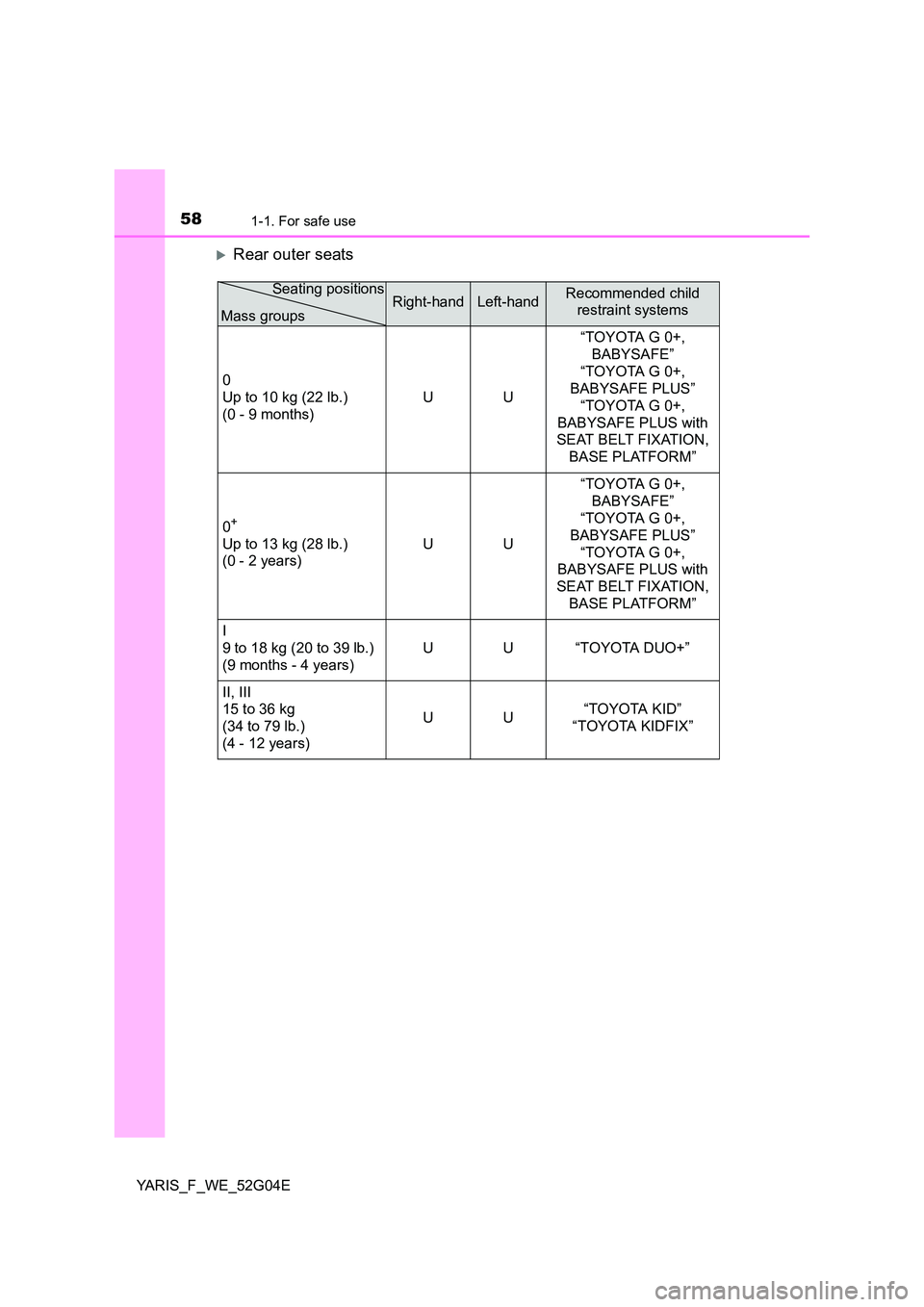
581-1. For safe use
YARIS_F_WE_52G04E
Rear outer seats
Right-handLeft-handRecommended child
restraint systems
0
Up to 10 kg (22 lb.)
(0 - 9 months)
UU
“TOYOTA G 0+,
BABYSAFE”
“TOYOTA G 0+,
BABYSAFE PLUS”
“TOYOTA G 0+,
BABYSAFE PLUS with
SEAT BELT FIXATION,
BASE PLATFORM”
0+
Up to 13 kg (28 lb.)
(0 - 2 years)
UU
“TOYOTA G 0+,
BABYSAFE”
“TOYOTA G 0+,
BABYSAFE PLUS”
“TOYOTA G 0+,
BABYSAFE PLUS with
SEAT BELT FIXATION,
BASE PLATFORM”
I
9 to 18 kg (20 to 39 lb.)
(9 months - 4 years)
U U “TOYOTA DUO+”
II, III
15 to 36 kg
(34 to 79 lb.)
(4 - 12 years)
UU “TOYOTA KID”
“TOYOTA KIDFIX”
Mass groups
Seating positions
Page 59 of 540
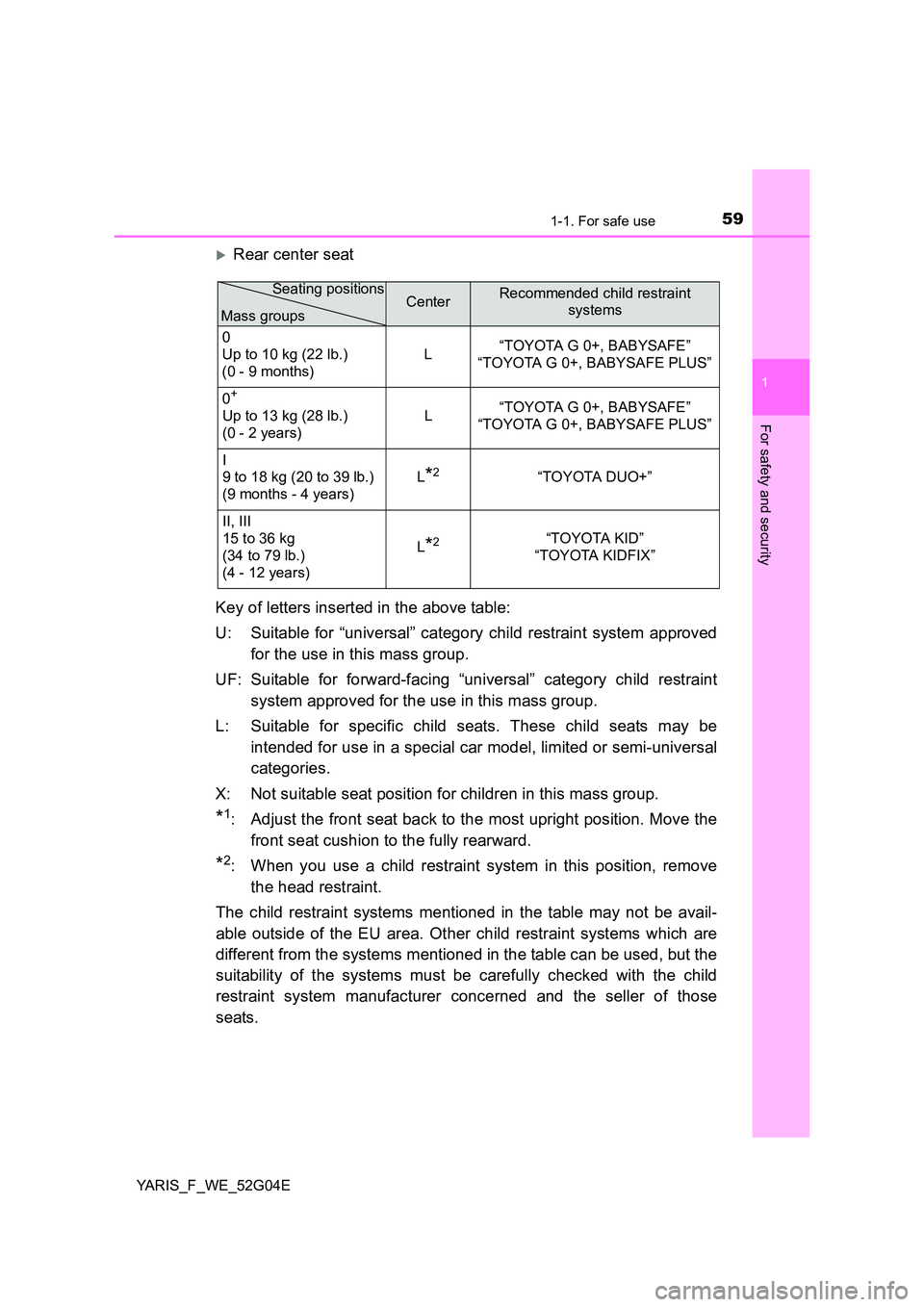
591-1. For safe use
1
For safety and security
YARIS_F_WE_52G04E
Rear center seat
Key of letters inserted in the above table:
U: Suitable for “universal” category child restraint system approved
for the use in this mass group.
UF: Suitable for forward-facing “universal” category child restraint
system approved for the use in this mass group.
L: Suitable for specific child seats. These child seats may be
intended for use in a special car model, limited or semi-universal
categories.
X: Not suitable seat position for children in this mass group.
*1: Adjust the front seat back to the most upright position. Move the
front seat cushion to the fully rearward.
*2: When you use a child restraint system in this position, remove
the head restraint.
The child restraint systems mentioned in the table may not be avail-
able outside of the EU area. Other child restraint systems which are
different from the systems mentioned in the table can be used, but the
suitability of the systems must be carefully checked with the child
restraint system manufacturer concerned and the seller of those
seats.
CenterRecommended child restraint
systems
0
Up to 10 kg (22 lb.)
(0 - 9 months)
L “TOYOTA G 0+, BABYSAFE”
“TOYOTA G 0+, BABYSAFE PLUS”
0+
Up to 13 kg (28 lb.)
(0 - 2 years)
L “TOYOTA G 0+, BABYSAFE”
“TOYOTA G 0+, BABYSAFE PLUS”
I
9 to 18 kg (20 to 39 lb.)
(9 months - 4 years)
L*2“TOYOTA DUO+”
II, III
15 to 36 kg
(34 to 79 lb.)
(4 - 12 years)
L*2“TOYOTA KID”
“TOYOTA KIDFIX”
Mass groups
Seating positions
Page 60 of 540
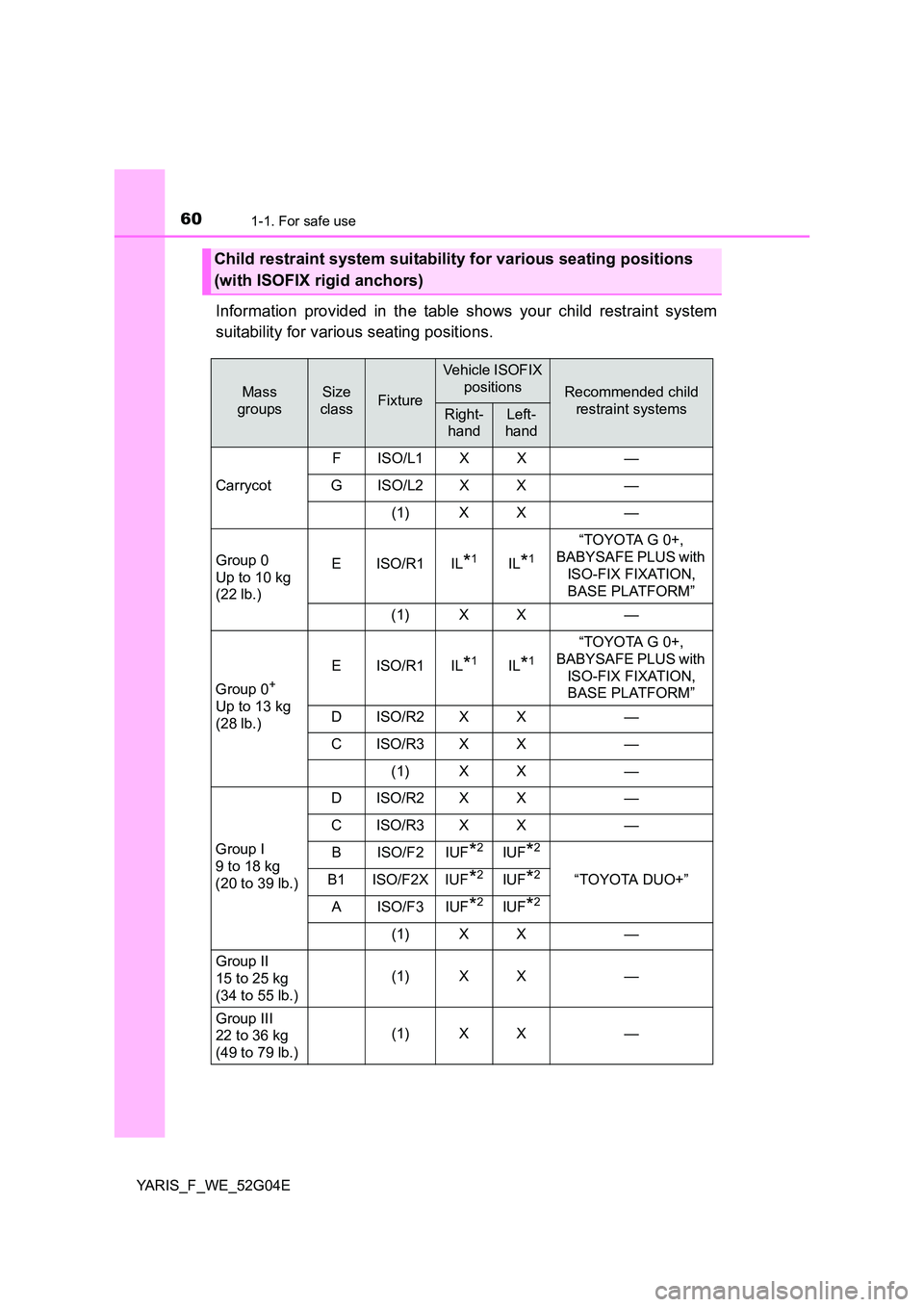
601-1. For safe use
YARIS_F_WE_52G04E
Information provided in the table shows your child restraint system
suitability for various seating positions.
Child restraint system suitability for various seating positions
(with ISOFIX rigid anchors)
Mass
groups
Size
classFixture
Vehicle ISOFIX
positionsRecommended child
restraint systemsRight-
hand
Left-
hand
Carrycot
FISO/L1X X —
GISO/L2 X X —
(1) X X —
Group 0
Up to 10 kg
(22 lb.)
EISO/R1IL*1IL*1
“TOYOTA G 0+,
BABYSAFE PLUS with
ISO-FIX FIXATION,
BASE PLATFORM”
(1) X X —
Group 0+
Up to 13 kg
(28 lb.)
EISO/R1IL*1IL*1
“TOYOTA G 0+,
BABYSAFE PLUS with
ISO-FIX FIXATION,
BASE PLATFORM”
DISO/R2X X —
CISO/R3X X —
(1) X X —
Group I
9 to 18 kg
(20 to 39 lb.)
DISO/R2X X —
CISO/R3X X —
BISO/F2IUF*2IUF*2
“TOYOTA DUO+” B1 ISO/F2X IUF*2IUF*2
AISO/F3IUF*2IUF*2
(1) X X —
Group II
15 to 25 kg
(34 to 55 lb.)
(1) X X —
Group III
22 to 36 kg
(49 to 79 lb.)
(1) X X —